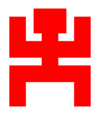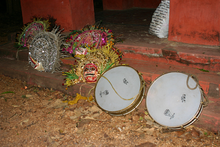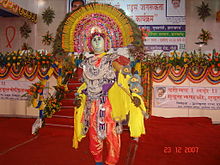- Chhau dance
-
A video of Chau dance in Purulia

Chhau dance (Bengali: ছৌ নাচ, Oriya: ଛଊ ନୃତ୍ୟ) is a genre of Indian tribal martial dance which is popular in the Indian states of Orissa, Jharkhand and West Bengal. There are three subgenres of the dance, based on its places of origin and development, Seraikella Chhau, Mayurbhanj Chhau and Purulia Chhau.[1]
Seraikella Chhau was developed in Seraikela, the present day administrative headquarters of the Seraikela Kharsawan district of Jharkhand, Purulia Chau was developed in Purulia district of West Bengal and Mayurbhanj Chhau was developed in Mayurbhanj district of Orissa. The most prominent difference among the three subgenres is in the use of mask. While, the Seraikela and Purulia subgenres of Chhau use masks, the Mayurbhanj Chhau uses none.[2][3]
Contents
Etymology
It is believed by some modern scholars that, the word Chhau, is derived from Sanskrit Chāya (shadow, image or mask), but according to Sitakant Mahapatra, it is derived from Chhauni (military camp).[1][4]
Purulia Chhau
The subgenre of Chhau performed in Purulia district and Jhargram subdivision of Paschim Medinipur District in West Bengal state, is referred to as the Purulia Chhau. It has a distinctive character of its own. It has received international acclaim and scaled rare heights of beauty and perfection. The approved theme of the West Bengal tableaux in the 1995 Republic Day celebrations at New Delhi was Chhau dance. Essentially a festival dance, Chhau was originally performed on the occasion of the Sun Festival towards the end of the month of Chaitra (March–April). The situation has changed with time, as Chhau is now performed during some other festivals and at other times of year as well.[5][6]
The Chhau dance is epical in content, and is based on various episodes of the Ramayana and the Mahabharata. Sometimes certain episodes of the Puranas are also used. The dominant rasas are Vira and Rudra. In the end, generally, forces of evil are vanquished and the righteous triumphs. In the villages, no dais or raised platform is used; the dance takes place on the ground around which, the spectators sit in a circle. When performing outside their villages the dancers often use the stage.[5] The dance, opens with the beating of drums followed by an invocation to Ganesha. by a singer. As soon as the singer finishes the song, host of drummers and musicians step in creates an in inexplicably wonderful environ prior to the dance. Ganesha appears followed in quick succession by other characters —gods, demons, animals and birds.[5]
Notes
- ^ a b Claus, p. 109
- ^ "Famous Folk Dance: "Chau"". Purulia district official website. http://purulia.gov.in/culture/chau.html. Retrieved 2009-03-15.[dead link]
- ^ Claus, p. 110
- ^ "The Chhau". Seraikela-Kharsawan district official website. http://seraikela.nic.in/chhau/chhau_hss.htm#SARAIKELACHHAU. Retrieved 2009-03-15.
- ^ a b c "West Bengal Chhau". India Line Expeditions. http://www.indialine.com/travel/westbengal/chhau.html. Retrieved 2008-03-02.
- ^ Barba, p. 207, 208
References
- Chhau dance of Purulia, by Asutosh Bhattacharya. Pub. Rabindra Bharati University, 1972.
- Barba, Eugenio; Nicola Savarese (1991). A dictionary of theatre anthropology: the secret art of the performer. Routledge. ISBN 0415053080. http://books.google.co.in/books?id=31WqQLGeXRIC&pg=PA207&dq=Chhau&lr=&cd=10#v=onepage&q=Chhau&f=false.
- Claus, Peter J.; Sarah Diamond, Margaret Ann Mills (2003). South Asian folklore: an encyclopedia. Taylor & Francis. ISBN 0415939194. http://books.google.co.in/books?id=ienxrTPHzzwC&pg=PA110&dq=Chhau+dance&lr=&cd=12#v=onepage&q=Chhau%20dance&f=false.
External links
- Chau: The Rare Mask Dances
- Purulia district website with information on Chhau
- Mauyrbhanj district website with information on Chhau
- Saraikela Kharsawan district website with information on Chhau
Bengali Hindus Castes 
Sects Religious Bodies Festivals Poila Baisakh · Rathayatra · Janmashtami · Bhadu · Vishwakarma Puja · Durga Puja · Lakshmi Puja · Kali Puja · Bhai Phonta · Nabanna · Jagaddhatri Puja · Makar Sankranti · Saraswati Puja · GajanFolk Arts Dhokra · SholapithFolk Dances Folk Songs Alkap · KaviganBengali culture General Art · Architecture of Bengal · Architecture of Bangladesh · Calendar · Cinema · Cuisine · History · Language · Literature · Music · Poetry · Renaissance · Script · Sport (Bangladesh) · Theatre · Wedding · Bengali people (list)
Specific Dhaki · Fairs in Birbhum · Folk literature · Jatra · Maimansingha Gitika · Nabanna · Panjika · Pohela Baishakh · Poush Mela · Rabindra Sangeet · Tarja
Folk songs and dances Crafts Bankura horse · Craft centres in West Bengal · Dhakai · Dhokra · Jamdani · Kantha · Nakshi Kantha · Sholapith
Categories:- Dances of India
- Oriya culture
- Culture of West Bengal
- Culture of Jharkhand
Wikimedia Foundation. 2010.


